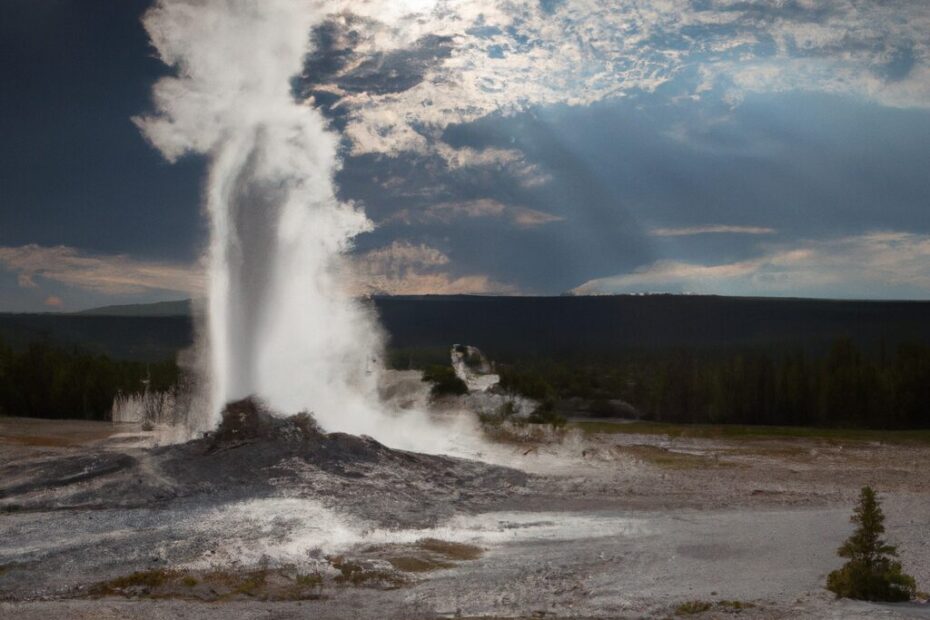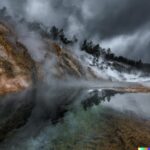Old Faithful, one of the most famous geysers in the world, is a natural wonder that captivates visitors with its predictable and impressive eruptions. But have you ever wondered how this marvel of nature was discovered or what causes it to erupt with such precision?
In this article, we will explore the fascinating details of Old Faithful, including its eruption schedule, duration, and height. We will also discuss the factors that affect its eruption schedule, such as weather, earthquake activity, and geothermal influences. We will uncover how you can predict an eruption of Old Faithful and the best time to witness this spectacular event.
If you’re curious about other geysers similar to Old Faithful, we’ve got you covered. Get ready to delve into the mesmerizing world of Old Faithful and its counterparts!
What is Old Faithful?
Old Faithful is a renowned geyser located in Yellowstone National Park, known for its consistent and spectacular eruptions that make it a significant geothermal landmark.
This iconic geyser, which was named for its reliable and predictable eruptions, showcases the powerful geological forces that shape the landscape of Yellowstone National Park. Old Faithful’s eruptions can reach heights of up to 180 feet, thrilling visitors with its display of steam and boiling water. As one of the most famous geysers in the world, it draws crowds of spectators who gather to witness nature’s incredible spectacle. Its status as a notable geothermal feature underscores the park’s rich volcanic history and unique geology.
How Was Old Faithful Discovered?
Old Faithful was discovered by geologists who recognized its unique geyser activity and distinct eruption patterns, leading to its identification as a prominent natural wonder.
As these geologists closely observed Old Faithful’s behavior, they noted how it reliably erupted at regular intervals, showcasing its mesmerizing spectacle of water spouts shooting high into the air. The geyser’s eruptions seemed to be almost choreographed, captivating all who witnessed the fascinating display of nature’s power. With their keen eye for detail, the geologists meticulously documented the patterns of Old Faithful’s eruptions, unraveling the secrets of this remarkable geological phenomenon.
What Causes Old Faithful to Erupt?
The eruption of Old Faithful is triggered by underlying geothermal activity and volcanic phenomena that create the necessary conditions for its spectacular displays of boiling water and steam.
This remarkable geyser’s eruptions are a result of the underground reservoir of hot water becoming superheated by geothermal heat from the Earth’s core. As this water reaches a boiling point, pressure builds up until it finally erupts through the surface, reaching heights of up to 180 feet. The volcanic influences in the region play a crucial role in this process, as the magma chambers beneath Yellowstone National Park create a unique environment of intense heat and pressure. These combined geological processes result in the predictable yet awe-inspiring eruptions that have captivated visitors for generations.
What is the Eruption Schedule of Old Faithful?
The eruption schedule of Old Faithful follows predictable intervals, making it a reliable geological timer that showcases the geyser’s consistent behavior over time.
This consistency in its eruption patterns has made Old Faithful a popular attraction for visitors, offering them the opportunity to witness the natural spectacle at regular and expected intervals. The geyser’s reliability has been studied by geologists and scientists who have used its predictability to understand the underlying geological processes that govern its eruptions. By adhering to its schedule, Old Faithful serves as a unique natural clock that demonstrates the remarkable precision of nature’s timing mechanisms.
How Often Does Old Faithful Erupt?
Old Faithful erupts at regular intervals, showcasing its volcanic activity in a predictable manner that mesmerizes visitors with its rhythmic eruptions.
The frequency at which Old Faithful erupts is a testament to the precise mechanisms underlying its volcanic behavior. These eruptions occur approximately every 60 to 110 minutes, making it one of the most reliably predictable geysers in the world. The anticipation that builds as visitors wait for the next eruption adds to the allure of this natural wonder. Witnessing the geyser shoot boiling water and steam high into the air truly captures the raw power and beauty of nature’s awe-inspiring forces.
What is the Duration of an Eruption?
The duration of an eruption at Old Faithful varies but typically lasts for a few minutes, offering a captivating display of geothermal power that characterizes the geysers in Yellowstone.
Visitors who witness Old Faithful’s eruptions are mesmerized by the explosive release of steam and boiling water that shoots up into the sky with an incredible force. This display is not just a spectacle but a testament to the unique characteristics of geysers found throughout Yellowstone National Park. Geysers like Old Faithful are rare natural features, fueled by underground reservoirs of hot water that periodically erupt in spectacular fashion, showcasing the raw power and beauty of geothermal activity in this geologically rich region.
What is the Height of an Eruption?
The height of an eruption at Old Faithful can reach impressive levels, sending boiling water and steam skyward in a mesmerizing display of geothermal energy.
Witnessing these eruptions is truly awe-inspiring as the boiling water shoots upwards with incredible force, creating a spectacle that showcases the raw power of nature. The sight of the steam rising high into the sky against the backdrop of the surrounding landscape is a reminder of the Earth’s immense geothermal activity. Tourists often gather around, captivated by the sheer height and intensity of the eruptions, feeling the heat and energy emanating from the geyser. It’s a reminder of the incredible forces at work beneath the Earth’s surface.
What Factors Affect the Eruption Schedule of Old Faithful?
Several factors influence the eruption schedule of Old Faithful, including geothermal activity, weather conditions, and seismic events that can alter the timing and intensity of its eruptions.
The geothermal activity beneath Yellowstone National Park plays a significant role in the predictability of Old Faithful’s eruptions. The underground heat sources create pressure build-up, leading to periodic releases of steam and water. Weather patterns, such as temperature and humidity, can also impact the eruption intervals. Seismic events like earthquakes can influence the stability of the geothermal system, affecting the geyser’s behavior. By studying these interconnected factors, researchers can gain insights into the complex mechanisms governing the iconic geyser’s activity.
What is the Influence of Weather on Eruptions?
Weather conditions play a significant role in influencing the eruptions of Old Faithful, affecting the geyser’s geothermal heating process and altering the timing and intensity of its displays.
The interplay between weather and Old Faithful’s eruptions is fascinating. Changes in atmospheric conditions directly impact the surrounding ground temperature, which in turn affects the geothermal reservoir feeding the geyser.
For example, colder temperatures can slow down the heating process, resulting in longer intervals between eruptions. Conversely, during warmer weather, the accelerated geothermal activity can lead to more frequent and intense displays.
This intricate relationship showcases the dynamic nature of natural systems and highlights the delicate balance between external influences and volcanic processes.
How Does Earthquake Activity Affect Eruptions?
Earthquake activity can influence the eruptions of Old Faithful by affecting the underground seismic vents that regulate the geyser’s geothermal activity and eruption patterns.
These seismic events can either enhance or inhibit the flow of water and steam within the underground channels, impacting the pressure build-up necessary for the geyser to erupt. When earthquakes occur near Old Faithful, they can alter the pathways through which water travels towards the surface, leading to variations in eruption intervals and intensities. The shifting of rocks and sediment caused by seismic activity can also block or open up passages within the underground network, directly influencing the geyser’s behavior.
What Role Does Geothermal Activity Play in Eruptions?
Geothermal activity serves a crucial role in the eruptions of Old Faithful, acting as the underlying force behind the geyser’s volcanic phenomenon and the spectacular displays of steam and hot water.
This natural source of heat from within the Earth’s crust plays a fundamental part in creating the intense pressure buildup necessary for Old Faithful’s eruptions. As underground water reservoirs are heated by the Earth’s mantle, they reach the boiling point, generating steam that eventually propels water upwards through Old Faithful’s vent. The combination of superheated water and steam results in the iconic eruptions that captivate visitors with their power and beauty, showcasing the intricate interplay between geothermal energy and the geyser’s volcanic activity.
How Can You Predict an Eruption of Old Faithful?
Geologists use various methods to predict the eruption cycle of Old Faithful, relying on observational data, seismic monitoring, and geothermal indicators to forecast the geyser’s next eruption.
The observational data collected includes the intervals between past eruptions, the duration of each eruption, and the height of the water column during eruptions. By analyzing these patterns, geologists can make educated guesses about when the next eruption might occur. In addition, seismic monitoring helps track the movement of underground fluids and pressure build-up, providing further clues on the geyser’s behavior. Geothermal signals, such as changes in water temperature and gas emissions, also play a crucial role in predicting Old Faithful’s eruptions by indicating the activity beneath the surface.
What is the Best Time to See an Eruption of Old Faithful?
The best time to witness an eruption of Old Faithful is during its regular intervals when the geyser behavior is most predictable, offering visitors a captivating display of geothermal activity.
These eruptions occur approximately every 90 minutes, making it easy for spectators to plan ahead and ensure they don’t miss the mesmerizing spectacle. The geyser’s reliability has made it one of the most famous natural attractions in Yellowstone National Park, drawing in crowds eager to witness the powerful bursts of water and steam shooting up into the sky. The rhythmic patterns of Old Faithful’s eruptions add an element of anticipation and excitement to the overall experience, creating a sense of wonder and awe among onlookers.
What Other Geysers are Similar to Old Faithful?
Several geysers share similarities with Old Faithful in terms of being geothermally heated and exhibiting regular eruptions, providing visitors with diverse geothermal displays within Yellowstone National Park.
- For example, the Castle Geyser, located in the Upper Geyser Basin, offers a striking resemblance to Old Faithful with its towering spout and predictable eruption cycles.
- Another notable geyser is the Riverside Geyser, situated along the Firehole River, known for its picturesque setting and consistent eruptions.
These geysers, along with others like the Grand Geyser and Daisy Geyser, contribute to the unique and captivating geothermal landscape found in Yellowstone. Visitors can witness the power and beauty of these natural wonders while exploring the park’s remarkable thermal features.
Last Updated on February 8, 2024 by Jon Waraas – Originally Posted: February 8, 2024

I’m Jon Waraas, and I’ve been navigating the online world since 2006. By day, I’m the proud owner of some eCommerce gems, and by night, I’m the voice behind the adventures on Waraas.Com.
My heart, however, belongs to the wild beauty of Yellowstone National Park. I’ve got a collection of websites dedicated to sharing the wonders of this natural masterpiece. Oh, and did I mention? I’m currently building my own cabin inside the ghost town of Gilmore, Idaho – a cabin with tales to tell!
When I’m not immersed in the digital realm, you’ll find me lacing up my boots for a good hike or setting up camp under the star-studded sky.




